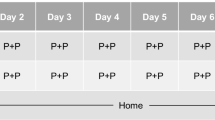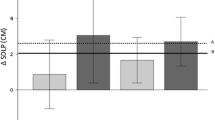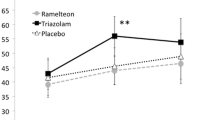Abstract
Rationale
The effects of hypnotic drugs on driving performance are most often evaluated on young healthy subjects by using a monotonous motorway driving test. The effects of drugs in urban driving situations have not yet been evaluated in any age group. Our objectives were to assess residual effects of the most prescribed hypnotics, zolpidem and zopiclone, on older middle-age drivers' capacities in an urban situation.
Materials and methods
Sixteen healthy subjects aged 55 to 65 years underwent this double-blind, balanced, cross-over study. Zopiclone (7.5 mg), zolpidem (10 mg), and flunitrazepam (1 mg; used as positive control) or a placebo were administered at each subject's home at 11:00 pm under the supervision of an investigator. The next morning, the subjects had to drive in a simulated urban environment where accident scenarios were introduced. Accident scenarios were implemented using data from real accident cases.
Results
Hypnotics did not significantly increase the number of collisions. However, significantly higher speeds were found with zopiclone and flunitrazepam; moreover, zolpidem and zopiclone induced modifications of the lateral position of the car on the road.
Conclusions
This study did not reveal any major residual effects of the hypnotics studied on driving performance in aging drivers. However, the urban driving situations used here for the first time in the evaluation of drugs revealed some modifications in driving habits which could lead to risky behavior. It thus appears that urban driving simulations are useful for gaining knowledge about the effects of drugs on driving behavior.



Similar content being viewed by others
References
Barbone F, Mac Mahon A, Davey P, Morris A, Reid I, MacDevitt D, MacDonald T (1998) Association of road-traffic accidents with benzodiazepine use. Lancet 352(9137):1331–1336
Behrensdorff I, Steentoft A (2003) Medicinal and illegal drugs among Danish car drivers. Accid Anal Prev 35:51–860
Berghaus G, Grass H (1997) Concentration-effect relationship with benzodiazepine therapy. In: Mercier-Guyon C (ed) Proceedings of the 14th International Conference on Alcohol. Drugs and Traffic Safety. Centre d'Etudes et de Recherchers en Médeccine du Traffic, Annecy, pp 705–709
Berthelon C, Bocca ML, Denise P, Pottier A (2003) Do zopiclone, zolpidem and flunitrazepam have residual effects on simulated task of collision anticipation? J Psychopharmacol 17:24–331
Berthelon C, Denise P, De Longcamp A (2004) Conduite automobile et effets résiduels des hypnotiques: apports de l’expérimentation. Recherche Transports Sécurité 84:03–216
Berthelon C, Nachtergaële C, Aillerie I (2008) Driving experience and simulation of accident scenarios. In: Dorn L (ed) Driver behaviour and training III. Ashgate Human Factors Publications, Ashgate, pp 277–289
Bocca ML, Denise P (2000) Residual effects of hypnotics on disengagement of spatial attention. J Psychopharmacol 14:401–405
Bocca ML, Le Doze F, Etard O, L’Hoste J, Pottier M, Denise P (1999) Residual effects of zolpidem 10 mg and zopiclone 7.5 mg versus flunitrazepam 1 mg and placebo on driving performance and ocular saccades. Psychopharmacology 143:373–379
Bocca ML, Marie S, Berthelon C, Coquerel A, Lelong-Boulouard M, Moessinger M, Denise P (2007) Hypnotics drugs residual effects on monotonous simulated driving in elderly drivers. Proceedings of the 18 th International conference on Alcohol, Drugs and Traffic Safety. 26–31 August 2007, Seattle, WA
Brundell-Freij K, Ericsson E (2005) Influence of street characteristics, driver category and car performance on urban driving patterns. Transp Res Part D 10:213–229
De Gier JJ (1999) Review of investigations of prevalence of illicit drugs in road traffic in different European countries. Proceeding of the Seminar Road and Traffic Drugs, organised by the co-operation group to Combat Drug Abuse and Illicit Trafficking in Drugs (Pompidou Group), 19 et 20 Avril 1999, Strasbourg, France. Publication du Conseil de l’Europe, pp 13-63
De Waard D, Dijksterhuisa C, Brookhuis KA (2009) Merging into heavy motorway traffic by young and elderly drivers. Accid Anal Prev 41:588–597
Denise P, Bocca ML (2003) Effects of zolpidem 10 mg, zopiclone 7.5 mg and flunitrazepam 1 mg on night-time motor activity. Eur Neuropsychopharmacol 13:111–115
Dubois S, Bédard M, Weaver B (2008) The impact of benzodiazepines on safe driving. Traffic Injury Prev 9:404–413
Espié S (1999) Vehicle-driven simulator versus traffic-driven simulator: the INRETS approach. Proceeding of the Driving Simulation Conference 99. Paris, France, 7-8 July 1999, pp 367-376
Filmore MT, Blackburn JS, Harrison LR (2008) Acute disinhibiting effects of alcohol as a factor in risky driving behaviour. Drug Alcohol Depend 95(1–2):97–106
Fleury D, Brenac T (2001) Accident prototypical scenarios. A tool for road safety research and diagnostic studies. Accid Anal Prev 33:267–276
Gustavsen I, Bramness JG, Skurtveit S, Engeland A, Neutel I, Mørland J (2008) Road traffic accident risk related to prescriptions of the hypnotics zopiclone, zolpidem, flunitrazepam and nitrazepam. Sleep Med 9(8):818–822
Herrlinger C, Klotz U (2001) Drug metabolism and drug interactions in the elderly. Best Prac Res Clin Gastroenterol 15:897–918
Kalmen H, Gustafson R (1998) Alcohol and disinhibition. Eur Addict Res 4:150–162
Linjakumpu T, Hartikainen S, Klaukka T, Veijola J, Kivelä SL, Isoaho R (2002) Use of medications and polypharmacy are increasing among the elderly. J Clin Epidemiol 55:809–817
Marquet P, Gautier JM, Merle L (1999) Les médicaments anxiolitiques, hypnotiques et antidépresseurs. In: Mura P (ed) Alcool, médicaments, stupéfiants et conduite automobile. Collection Option Bio, Elsevier, pp 21–58
Maycock G (2001) Forecasting older-driver accidents and casualties. Road Safety Research Report N°23, Department of the Environment, Transport and the Regions DETR, London
Moessinger M, Muzet A (2001) La personne âgée et la conduite automobile: analyse et reflet de l'émergence d'un phénomène de société. Soins Gérontologie 31:38–43
Movig KLL, Mathijssen MPM, Nagel PHA, van Egmondd T, de Gier JJ, Leufkens HGM, Egberts ACG (2004) Psychoactive substance use and the risk of motor vehicle accidents. Accid Anal Prev 36:631–636
Neutel CI (1995) Risk of traffic accident injury after a prescription for a benzodiazepine. Ann Epidemiol 5:239–244
O’Hanlon JF (1995) Zopiclone's residual effects on psychomotor and information processing skills involved in complex tasks such as car driving: a critical review. Eur Psychiatry 10(suppl. 3):137s–143s
O’Hanlon JF, Brookhuis KA, Louwerens JW et al (1986) Performance testing as part of drug registration. In: O’Hanlon JF, De Gier JJ (eds) Drugs and driving. Taylor and Francis, London, UK, pp 311–320
Ohayon MM, Lader MH (2002) Use of psychotropic medication in the general population of France, Germany, Italy, and the United Kingdom. J Clin Psychiatry 63:817–825
Sanger DJ (2004) The pharmacology and mechanisms of action of new generation, non-benzodiazepine hypnotic agents. CNS Drugs 18(suppl 1):9–15
Shiffrin RM, Schneider W (1977) Controlled and automatic human information processing: perceptual learning, automatic attending, and a general theory. Psychol Rev 84:127–190
Vermeeren A (2004) Residual effects of hypnotics: epidemiology and clinical implications. CNS Drugs 18:297–328
Verster JC, Veldhuijzen DS, Volkerts ER (2004) Residual effects of sleep medication on driving ability. Sleep Med Rev 8:309–325
Verster JC, Veldhuijzen DS, Patat A, Olivier B, Volkerts ER (2006) Hypnotics and driving safety: meta-analyses of randomized controlled trials applying the on-the-road driving test. Curr Drug Saf 1:63–71
Vuyk J (2003) Pharmacodynamics in the elderly. Best Prac Res Clin Anaesthesiol 17:207–218
Walsh JM, de Gier JJ, Christopherson AS, Verstraete AG (2004) Drugs and driving. Traffic Injury Prev 5:241–253
Williams EJ (1949) Experimental designs balanced for the estimation of residual effects of treatments. Aust J Sci Res 2(3):149–168
Acknowledgements
We would like to thank the simulation team at INRETS (Modélisations, simulations et simulateurs de conduite [MSIS]), notably Isabelle Aillerie and Fabrice Vienne, for designing the displays.
This research was supported by a grant from the French National Research Agency, grant no.ANR 05-PDIT-004-10 DACOTA.
Author information
Authors and Affiliations
Corresponding author
Rights and permissions
About this article
Cite this article
Meskali, M., Berthelon, C., Marie, S. et al. Residual effects of hypnotic drugs in aging drivers submitted to simulated accident scenarios: an exploratory study. Psychopharmacology 207, 461–467 (2009). https://doi.org/10.1007/s00213-009-1677-2
Received:
Accepted:
Published:
Issue Date:
DOI: https://doi.org/10.1007/s00213-009-1677-2




